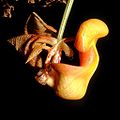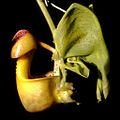- Coryanthes
-
Coryanthes 
Coryanthes verrucolineata Scientific classification Kingdom: Plantae (unranked): Angiosperms (unranked): Monocots Order: Asparagales Family: Orchidaceae Subfamily: Epidendroideae Tribe: Maxillarieae Subtribe: Stanhopeinae Genus: Coryanthes
Hook.Species - Coryanthes albertinae
- Coryanthes alborosea
- Coryanthes balfouriana
- Coryanthes barkeri
- Coryanthes bergoldii
- Coryanthes bicolorata
- Coryanthes biflora
- Coryanthes bruckmuelleri
- Coryanthes boyi
- Coryanthes colinata
- Coryanthes elegantium
- Coryanthes eximia
- Coryanthes gerlachiana
- Coryanthes gernotii
- Coryanthes hunteriana
- Coryanthes leucocorys
- Coryanthes macrantha
- Coryanthes macrocorys
- Coryanthes maculata
- Coryanthes mastersii
- Coryanthes misasii
- Coryanthes parkeri
- Coryanthes picturata
- Coryanthes punctata
- Coryanthes powellii
- Coryanthes sanderi
- Coryanthes speciosa
- Coryanthes splendens
- Coryanthes sumnerana
- Coryanthes trifoliata
- Coryanthes vasquezii
- Coryanthes verrucolineata
- Coryanthes wolfii
Synonyms - Meciclis Raf.
- Panstrepis Raf.
Coryanthes, commonly known as Bucket Orchids, is a genus of tropical epiphytic orchids. This genus is abbreviated as Crths in horticultural trade.
Bucket orchids are an excellent example of coevolution and mutualism, as the orchids have evolved along with orchid bees (the tribe Euglossini of the family Apidae) and both depend on each other for reproduction. One to three flowers are borne on a pendant stem that comes from the base of the pseudobulbs. The flower secretes a fluid (see Coryanthes alborosea picture) into the flower lip, which is shaped like a bucket. The male orchid bees (not the females) are attracted to the flower by a strong scent from aromatic oils, which they store in specialized spongy pouches inside their swollen hind legs, as they appear to use the scent in their courtship dances in order to attract females. The bees, trying to get the waxy substance containing the scent, sometimes fall to the fluid-filled bucket. As they are trying to escape, they find that there are some small knobs on which they can climb on, while the rest of the lip is lined with smooth, downward-pointing hairs, upon which their claws cannot find a grip. The knobs lead to a spout (see the Coryanthes leucocorys picture), but as the bee is trying to escape, the spout constricts. At that same moment, the small packets containing the pollen of the orchid get pressed against the thorax of the bee. However, the glue on the pollen packets does not set immediately, so the orchid keeps the bee trapped until the glue has set. Once the glue has set, the bee is let free and he can now dry his wings and fly off. His ordeal may have taken as long as forty-five minutes. Hopefully, the bee will go to another flower, where, if the flower is to be successful at reproducing, the bee falls once again into the bucket of the same species. This time the pollen packets get stuck to the stigma as the bee is escaping, and after a while the orchid will produce a seed pod.
The bee, having stored the aromatic oils in his back legs, can then fly off to mate with a female bee.
Contents
History
Some of the first investigations on Coryanthes were published by Cruger in 1865.[1] Charles Darwin describes his observations and experiments on some species of Coryanthes in his book The Various Contrivances by which Orchids are Fertilized by Insects.[2] However, Darwin thought it was the female bees that were doing the fertilizing, and it was almost 100 years before the role of the male euglossine bees were revealed in 1961.[3]
Intergeneric hybrids
- Coryhopea (Coryanthes × Stanhopea)
Gallery
References
- ^ H. Cruger (1865) A few notes on the fecundation of orchids and their morphology. J. Linn.Soc.London–Bot.8:127–35
- ^ Charles Darwin, D. Appleton (1877) The Various Contrivances by which Orchids are Fertilized by Insects.
- ^ Dodson, C. H. and G.P. Frymire (1961) Natural pollination of orchids. Mo. Bot. Gard. Bull. 49(9):133-152
External links
http://www.livevideo.com/video/97D589C0C6254284BC9EA9F1888A7D9C/richard-dawkins-lecture-4-the-ultraviolet-garden-2-of-7-.aspx In a video lecture directed at children Richard Dawkins includes a segment that shows a Euglossine bee being "tricked" by an orchic. The relevant segment is some distance into the nine minute video.
Categories:- Orchid genera
- Plants and pollinators
- Coryanthes
Wikimedia Foundation. 2010.












